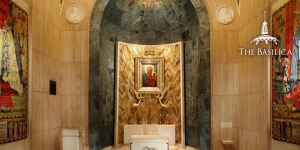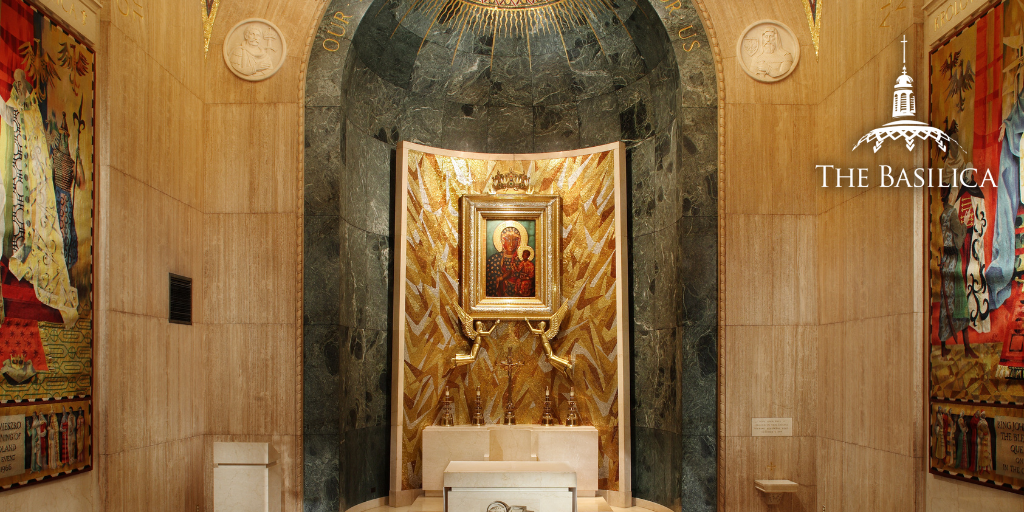
Did you know that art depicting Mary as the Mother of God usually falls into two categories? These are the Hodegetria – “she who shows the way” or “the guide”; and the Eleousa – “the one who shows mercy” or the “tender touch.” The Hodegetria depicts Mary holding the Christ Child while pointing towards Him with her right hand. As Mary presents her son, the source of salvation, to the world, the Child raises His right hand, symbolizing Jesus’s divine authority to bless and to teach. The Eleousa is the more intimate of the two, showing Mary cheek to cheek with the Christ Child, a moment of tenderness between mother and son. Jesus focuses His attention on His mother, embracing her.
As we observe Mother’s Day this Sunday, we invite you to explore seven places you can find Mary portrayed as Mother in the Basilica – as both the Guide and the Eleousa.
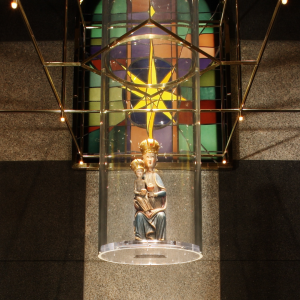 Our Lady of Mariazell Chapel – The Guide
Our Lady of Mariazell Chapel – The Guide
The tradition of the devotion to Our Lady of Mariazell dates to 1157, when a miraculous event happened to a monk named Magnus. One day, when Magnus was traveling, he found his path barred by a vast boulder. Faced with this obstacle, he placed a small statue of Mary that he was carrying with him on the rock and prayed for guidance. To his astonishment, the rock split in two, allowing him to pass. After this miracle, he built a small cell (in German “zell”) in which to live and pray, which became a monastery and a church, and still stands as pilgrimage site for the faithful today.
This Marian devotion is honored in the Basilica in the Chapel of Our Lady of Mariazell, which was the first chapel to be donated to the Basilica by a country outside the United States. The focal point of the chapel is an exact replica of the statue of Our Lady of Mariazell, made of linden wood and measuring only 19 inches tall. Mary holds a fig, symbolizing sin, while Jesus holds an apple, symbolizing redemption. The statue features a red seal, indicating that it was touched to the original and carries the same graces.
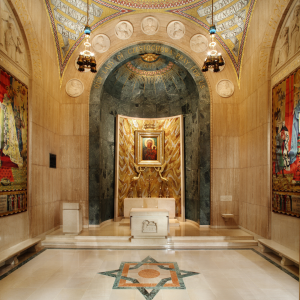 Our Lady of Czestochowa Chapel – The Guide
Our Lady of Czestochowa Chapel – The Guide
The history of the devotion to Our Lady of Czestochowa dates to the 14th century, when Prince Ladislaus of Opole, Vice Regent of Poland, brought the icon to Czestochowa in 1382. There, the Pauline Fathers took guardianship of the icon in their monastery at Jasna Gora, “The Bright Hill.” Unfortunately, when the shrine came under attack from the Hussites on Easter Sunday in 1430, the icon was slashed with a sword, marring Mary’s face with scars. The region once again was imperiled 200 years later when the Swedish army began to invade; but miraculously, the monastery was untouched. In the wake of this astonishing event, King Jan Casimir declared the Blessed Virgin to be Queen of Poland on April 1, 1656. This Marian devotion remained close to the heart of the Polish people throughout the ages and was especially significant to Pope John Paul II and the Solidarity Movement in Poland.
In the Chapel of Our Lady of Czestochowa at the Basilica, the icon is an inexact copy of the original by Polish artist Leonard Torwirt. While the Basilica icon bears the same “scars” the Blessed Mother has in the original, it has additional ornamentation on the halo of the Virgin and Child. Symbols of royal lineage grace her adornments; her robe is embellished with fleur-de-lis and her brow is set with a six-pointed star.
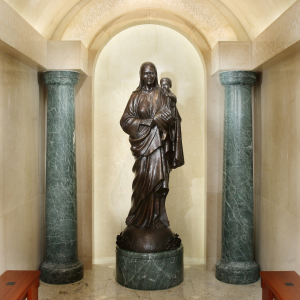 Our Mother of Africa Chapel – The Guide
Our Mother of Africa Chapel – The Guide
A gift of the National Black Catholic Congress, the Chapel of Our Mother of Africa stands in remembrance of the painful history of slavery in the United States and the pillar of hope which Our Lady represented to enslaved peoples. The chapel is centered around a bronze sculpture of the Blessed Mother holding the Christ Child, who points toward the narrative relief of the African-American experience from slavery to emancipation. The relief sculpture culminates in a mother and father, freed from the bronze of the relief, stepping into the nave and lifting their arms to Christ on the cross.
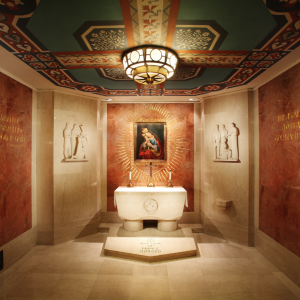 Our Lady of Brezje Chapel – The Tender Touch
Our Lady of Brezje Chapel – The Tender Touch
The original painting of Our Lady of Brezje, also known as Mary, Help of Christians, was completed in 1814 by artist Leopold Layer and resides in the Church of St. Vitus in Brezje, Slovenia. The Our Lady of Brezje Chapel in the Basilica features a copy of the original oil painting, with the infant Jesus reaching up and touching Mary’s face. Both wear ornate gold crowns, crafted by goldsmith Alojz Źmuc. Four marble reliefs depict the baptism of the Slovenian Prince Gorazd, Bishops Slomšek and Baraga, and Slovenian immigrants to the U.S.
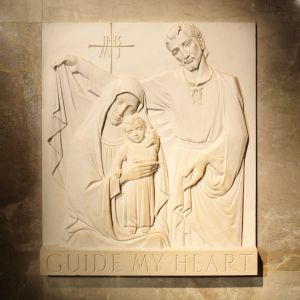 The Holy Family Oratory – The Tender Touch
The Holy Family Oratory – The Tender Touch
The Holy Family Oratory features a Trani marble bas-relief of Jesus, Mary, and Joseph. Here, Mary is depicted with her hands resting on the Christ Child’s shoulder and arm, tilting her face down towards his. Fashioned by Theodore C. Barbarossa, it is the gift of Mrs. Carol Fox Kennedy, wife of National Shrine architect, Eugene F. Kennedy, Jr., Boston, Massachusetts (1961).
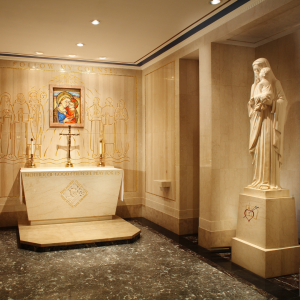 Our Mother of Good Counsel Chapel – The Tender Touch
Our Mother of Good Counsel Chapel – The Tender Touch
On the Feast of St. Mark in 1467, a cloud descended upon the ruins of a fifth-century church in Genazzano, Italy. Upon its disappearance, the people of the village discovered a small picture of the Madonna and Child on a thin sheet of plaster. The miraculous image remained delicately balanced on a ledge in the church for years, even surviving a bombing during World War II, and came to be known as Our Mother of Good Counsel. The image is replicated in the Basilica’s Our Mother of Good Counsel Chapel, portraying Mary as the Eleousa, holding the Christ Child close. Around the mosaic are depictions of men and women who were devoted to Our Mother of Good Counsel. On the right of the altar, Our Mother of Good Counsel is also sculpted in Trani marble.
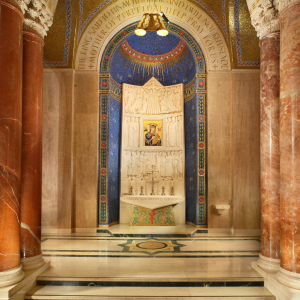 Our Mother of Perpetual Help Chapel – The Tender Touch
Our Mother of Perpetual Help Chapel – The Tender Touch
Associated with a 15th-century Byzantine icon of the Madonna and Child, Our Mother of Perpetual Help is known for miracles and answers to prayer. At the Basilica, the Mother of Perpetual Help Chapel features a mosaic reproduction of the Mother of Perpetual Help icon. Mary comforts the Child Jesus as he turns in fear from the Archangels Michael and Gabriel, who brandish the instruments of the passion. Surrounding the icon are Botticino reredos depicting saints including Alphonsus Liguori and Luke the Evangelist.
Source:
Rohling, Geraldine M., PhD, MAEd. The Basilica of the National Shrine of the Immaculate Conception: Guide and Tour Book. Washington, D.C.: Basilica of the National Shrine of the Immaculate Conception, 2018.

